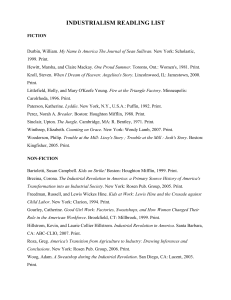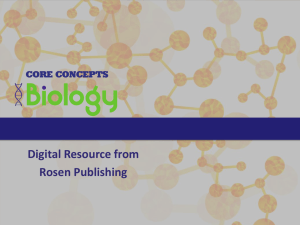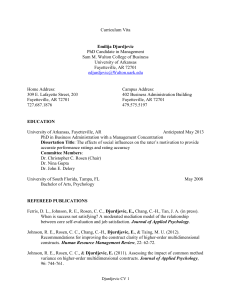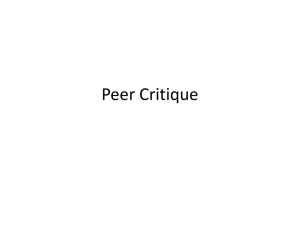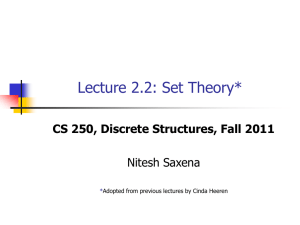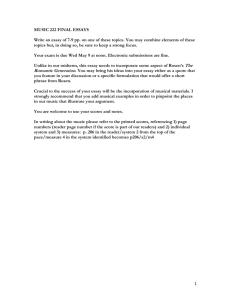Discovering Relations
advertisement
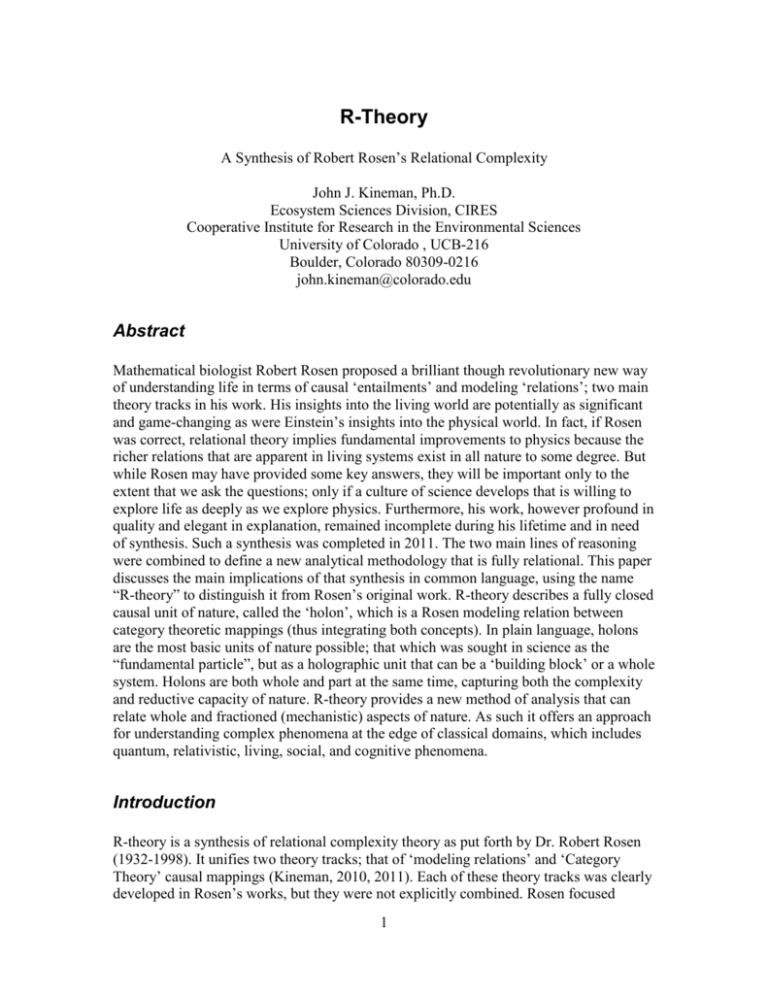
R-Theory A Synthesis of Robert Rosen’s Relational Complexity John J. Kineman, Ph.D. Ecosystem Sciences Division, CIRES Cooperative Institute for Research in the Environmental Sciences University of Colorado , UCB-216 Boulder, Colorado 80309-0216 john.kineman@colorado.edu Abstract Mathematical biologist Robert Rosen proposed a brilliant though revolutionary new way of understanding life in terms of causal ‘entailments’ and modeling ‘relations’; two main theory tracks in his work. His insights into the living world are potentially as significant and game-changing as were Einstein’s insights into the physical world. In fact, if Rosen was correct, relational theory implies fundamental improvements to physics because the richer relations that are apparent in living systems exist in all nature to some degree. But while Rosen may have provided some key answers, they will be important only to the extent that we ask the questions; only if a culture of science develops that is willing to explore life as deeply as we explore physics. Furthermore, his work, however profound in quality and elegant in explanation, remained incomplete during his lifetime and in need of synthesis. Such a synthesis was completed in 2011. The two main lines of reasoning were combined to define a new analytical methodology that is fully relational. This paper discusses the main implications of that synthesis in common language, using the name “R-theory” to distinguish it from Rosen’s original work. R-theory describes a fully closed causal unit of nature, called the ‘holon’, which is a Rosen modeling relation between category theoretic mappings (thus integrating both concepts). In plain language, holons are the most basic units of nature possible; that which was sought in science as the “fundamental particle”, but as a holographic unit that can be a ‘building block’ or a whole system. Holons are both whole and part at the same time, capturing both the complexity and reductive capacity of nature. R-theory provides a new method of analysis that can relate whole and fractioned (mechanistic) aspects of nature. As such it offers an approach for understanding complex phenomena at the edge of classical domains, which includes quantum, relativistic, living, social, and cognitive phenomena. Introduction R-theory is a synthesis of relational complexity theory as put forth by Dr. Robert Rosen (1932-1998). It unifies two theory tracks; that of ‘modeling relations’ and ‘Category Theory’ causal mappings (Kineman, 2010, 2011). Each of these theory tracks was clearly developed in Rosen’s works, but they were not explicitly combined. Rosen focused 1 primarily on laying the mathematical and epistemological foundation of relational theory, leaving deeper implications, except for numerous hints, to be discovered through experience. As we explore the implications of R-theory, the truly revolutionary character of Rosen’s work becomes apparent. The epistemological and ontological issues of ‘un-reducing’ science as will be described here, are what Rosen faced in his mission to unravel the mystery of what, in mathematical and causal terms, makes a system complex or living. He gave many compelling and yet compassionate arguments explaining why a radical change in how we approach science is needed. And yet, despite providing all the ingredients for this change, and heralding its necessity, he left it to his followers to complete the task of theoretical synthesis. From both his writings and accounts of conversations (Judith Rosen, personal communication), it seems that Rosen made a choice to leave the full synthesis unfinished. Whether it was to limit the hardships of a counter-cultural scientist, to delay the arrival of knowledge he was afraid we would misunderstand and misuse, or simply to retain his sharp focus on the foundations of living systems, he nevertheless left the synthesis to be accomplished almost as a test, not just of our wit but also of our resolve. Perhaps, as an accomplished mathematician he even saw some appeal in leaving his followers with a conundrum, as Pierre de Fermat had so famously done three and a half Centuries before. The Necessity of Complex Analysis In over 300 years of science in the West we have perfected a method of ‘seeing’ nature as a dynamical system of efficient and material causes (two of the four natural causalities identified by Aristotle), constrained by presumably unchanging laws and parameters (constants and metrics) of a single, universal context that unifies formal cause. This is the mechanistic (also Newtonian and classical) paradigm in which we try to describe nature as if it were governed by regularities that can be rigidly specified. This view has dominated science up to its post-modern reinvention, and it retains its grip even if now swinging by only one arm. Aristotle’s final cause was left out of the picture entirely as belonging to mystical realms, and prior to the discovery of the quantum world formal cause was indeed thought to be fully describable as one closed system of logic applying to the entire universe. If Robert Rosen has told us anything, it is that this narrow view of nature must now be broadened to embrace all four causes in a new synthesis. In that synthesis, we must understand these causes as establishing two categories of entailment that mirror each other in a fully natural modeling holarchy; something Aristotle himself did not imagine. The post-modern crisis in physics was about accepting formal system dependency; whereas now the challenge extends to categorical dualism involving all four causes. As Rosen himself wrote, we do not entertain such a sweeping ontological change in science lightly; we are forced to it by evidence and reason (Rosen, 1985; Appendix). In Rosen’s collective works, he showed clearly that the mechanistic view of science is associated with a category of general mathematics that allows us, and restricts us, to 2 creating simple approximations of nature’s complex behaviors. Rosen indirectly explored the implications of formal and final cause, which seem to be critically involved in establishing, and thus defining, complex systems and especially in characterizing living systems. These ‘higher’ causes have not been well understood within the scientific community. In fact, it can be said that we have not had a useful theory of these causes in the sciences to date. To a very large extent, Rosen’s methodical developments were aimed at developing a theory that would account for the effects of formal and final causes in our scientific images of nature, and thereby provide a more rigorous foundation for complexity science. There is no suggestion in Rosen’s work, however, that the approach of Western science has been generally wrong for its intended purpose; only that it is limited, lacking consideration of important aspects needed to represent the case of life and true complexity. He described a “simple” system as one that can have a complete model as hoped for in most of science; a criterion that characterizes non-complex, computable, dynamical or mechanistic systems. Such systems can be explained by efficient and material causes under the presumption that they exist within a self-contained system of formal cause (and consequently describable by a single ‘largest’ formalism). Rosen described such assumptions as “too impoverished” mathematically to allow modeling complexity or life, and yet “...still the only thing we know how to work with”. The aim of much of Rosen’s work was to provide tools to allow us to work with more. We can infer from the sum of Rosen’s work that the inadequacy of the mechanistic view is rooted in its simplification of formal and final causes; its attempt to overlook or reduce them to efficient and material laws that might be made complete in themselves. In contrast, Rosen’s relational theory suggests that it is possible to expand science by reincluding the contextual causes that mechanism left out. If we do so, we see nature itself establishing and realizing its own formal paradigms. In other words, systems can establish the context for other systems and therefore formal cause can vary between natural systems, ensuring that no single descriptive formalism can be complete (and thus considering ‘reality’ to be fundamentally system-dependent except when reduced to common elements). Complexity vs. Simplicity Rosen brought us from the limitations of the dynamical system description to the edge of complexity, which he saw as existing mathematically in the infinite limit beyond what any combination of mechanistic system descriptions is capable of representing. The mechanistic approach has been a powerful method for gaining knowledge about certain aspects of our natural world and for supporting the development of technology precisely because it selects phenomena that have a simple explanation and measurable existence. It presumes that events have a single past configuration and a single future one, such that the future configuration of a system can be predicted on the basis of past events and determined outcomes. The success of this paradigm is obvious, but the notable failure of its complete “formalization” (as attempted by Hilbert, Goedel, and others) led a retreat to 3 expressing the formal side of nature in terms of probability. Probability theory occupies a strange place in science, as a grand compromise on the aims of rigid description, and yet as itself an implicit natural formalism. On the one hand it allows the needed flexibility in the ‘precise’ description of nature, stepping partially away from Newtonian determinism; but it does so without an ontological commitment. Probability theory can equally describe our lack of knowledge of a system. As a quasi-ontological realism (as in quantum physics) and a cover for error (in all other fields), the expedient of describing all incommensurate contexts in terms of probability takes a step toward the relational view but stops short of exploring deeper relational wholeness. Relational holism involves all four of Aristotle’s causes in a closed, recursive holarchy that extends across all scales and phenomena without upper or lower bounds. While possibly dissatisfying in not providing a bounded description of nature, that very feature allows it to focus on wholeness from the start and explore contributing relations as needed. While reduction of apparently formal effects to efficient laws may be possible in some cases, there are many systems and situations where that would be inappropriate and impossible to formulate. As a matter of definition, events that cannot be reduced to a reconfiguration of existing states (efficient cause) can only be represented in the higher causes as an origin of new phenomena (final and formal cause). The wholeness of a system is thus the set of relations involving both its origin and behavior. The epistemological separation between observers of nature – a scientist perhaps – and what can be observed, is what establishes the simple mechanistic view. It uses natural systems – ourselves – to describe nature as a set of external events that then appear to belong to a universe that has been separated from the context in which we perceive it. The more we formalize that view, the more nature appears to be separated from all information contexts. In other words, what we observe is what can be seen, not what sees. If we do not then reason, from ample evidence, that nature ‘sees’ by modeling itself, we will not include that aspect of nature in our scientific models. By ‘see’ or ‘perceive’ is meant an information relation that is fundamentally different from the kinds of law-like interactions we can observe of well-defined material objects; one that is, in contrast, contextual. The context of system realizations like a natural model that is encoded and decoded with events; and in that sense our information context is also natural. Hence there is a complex relation between contextual and realized domains. Thus when analyzing a complex system the assumption that there are no natural information contexts other than our own can no longer be maintained. Rosen concluded that our entire concept of information must change; from the narrow basis it has had so far that developed in military cryptology (i.e., Shannon-Weaver theory), to a concept of epistemological and natural coding relations. Most notably, the theory establishes no absolute separation in nature or science between signals and interpreters (contrary to the aim of cryptology). Instead, it describes natural information relations in terms of their connection, albeit incomplete in ways that give us both harmony and diversity. We must understand that the essence of this principle is built into the foundation of physical interactions, and its reduction or manifestation is associated with the degree to which systems alter each other’s form; that is, interact with or ‘in-form’ each other. Living 4 organisms rescue and organize natural autonomy by internalizing and thus isolating entailments from external information. A unique form of causal closure represented in Rosen’s “M-R systems” achieves this result in living systems. But other less complete closures can exist in non-living systems as well. To account for relational complexity, Rosen found it necessary to “retreat” to a broader mathematical and conceptual foundation; to relax the restrictions that define mechanistic or dynamical systems and thereby to develop a more general mathematics for complex systems in which “the entire epistemology of our approach to natural systems is radically altered.” To understand Rosen’s approach and its departure from the definitions that restrict us to dynamical systems theory, we must first understand, from his own characterization, that the “ingredients” of his approach are “the basic notions of information” (Rosen, 1985), which are the basic notions of relation between a model (the contextualized relations) and its behavior (the realized relations). Furthermore, we must always bear in mind that simplicity, not complexity, is what interaction constructs; whereas complexity is the fundamental principle prior to interactive definition. There is no escaping that this is a view of an informational universe; and with regard to its consciousness or intelligence we are no longer discussing essence, but degree. It has not been immediately obvious, of course, how to describe that broader mathematical view; what analytical method can be used to describe relations without either simplifying them to mechanisms, generalizing them as probabilities, or making them seem mysterious. Rosen’s work and the recent synthesis addressed that middle ground that has eluded us for centuries. Complex systems, which we must now accept as the fundamental nature of all systems, are characterized by modeling relations, which are relations between realizations and contexts. A key issue in establishing this synthesis was therefore to reify the contextual domain as a part of nature. To do that one must specify how a realized entity exerts a contextual influence, that is how natural objects establish natural laws. As Rosen wrote (Rosen, 2000; Chapter I, citing Erwin Schrödinger), it is the case of an ‘inertial object’ (a material result) acting as a ‘gravitational object’ (a cause of dynamics). That translation is accomplished by one system acting as the context for another. An interaction between realized systems involves an inversion of properties of one system into contextual potentials, which are natural models, and then a subsequent realization in the other system. Models mirror their realizations as a set of enabling conditions. Whereas realizations are unique existences, models are distributed and intersecting conditions of a generating environment. The R-Theory Holon There were two lines of reasoning emphasized more or less equally in Rosen’s theoretical work. Although Rosen himself did not fully integrate them, he showed how to put the ingredients together. One theory track was the mapping of entailments using category theory, the more general foundation that Rosen referred to in mathematics. The other track was the ontology and epistemology of modeling relations, which are explicitly formed of two-way information relations between models and natural systems. The 5 combination of these two tracks gives us a holistic view of relational theory and allows us to define a mathematical object that is arguably the least reducible unit of nature; the holon. A holon, as defined here,1 is a multiple complementarity, decomposable into generative (intrinsic) and interactive (extrinsic) relations comprising causal entailments in contextually related categories. Together, those relations are natural instances of modeling relations. That unique organization of causes defines wholeness and gives identity to systems, which then interact by sharing or substituting causes. As suggested by this description, we might understand R-theory best by considering the idea of causal insides and outsides of systems;2 that every system or event viewed in terms of its outside relations (the basis of the mechanical/dynamical view), must also exist on the inside of another system of which the intrinsic relations provide a context for the first system. Thus every system has generative relations and interactive relations with other systems. These relations establish autonomous identity and interactive attributes, respectively, as a four-cause holon (Figure 1). The generative and interactive mappings of system A (the holon taken together with its four facets) are represented mathematically by arrow diagrams; however, ambient relations interact with A as a physical object (which may include objects that we might explain from general laws), whereas internalized relations act as a generative context. 1 The term was coined by Arthur Koestler, as a system that is both part and whole. Not to be confused with material boundaries, although they may be related, for example in organisms. The “generative relations” in Figure 1 may be internalized relations, but mainly they have different closures than the general environment. 2 6 Figure 1 is a template for complex analysis of any phenomenon. It shows how A can be created or altered by external causes, and how A can also be self-entailed from internal causes, and thus achieve a certain degree of autonomy. New symbols were proposed to extend traditional Category Theory mapping algebra to the higher causes. Contextual entailment is represented with dashed arrows, contrasted with solid arrows for realized entailment; and each of the four aspects of the system (two epistemological aspects vertically and two Figure 1: Relational Holon, A, with generative and interactive relations ontological aspects horizontally) is labeled by formatting of the holon identity symbol differently (in this case different versions of the letter A). The four quadrants where mappings occur are each of the four causes; starting from the upper-left, efficient, material, final, and formal. Entailment is a combination of arrows with open and solid heads, whereas relation is with a similar pair of heads (open representing encoding via structure, and solid representing decoding via function).3 The identity of A is shown by a single causal loop between the four aspects. As the branching arrows indicate, holons can be connected at any quadrant or combination of quadrants. Any cause may thus be associated with an entire holon (which substitutes for a quadrant). Therefore what we analyze as a single causality is explainable as an effect of another whole natural system. There is no limit to the extent of these relations; no ‘smallest’ system and no ‘largest system’ and therefore no complete description or fundamental ‘particle’. Every scientific theory is incomplete in some way; the question is what it brings into focus and what it leaves unknown. The incompleteness of mechanical description with respect to explaining complexity allows it to focus on mechanisms, while the indefinite extent of contextual description with respect to defining states allows it to focus on system wholeness. Both descriptions are needed, and relational theory is more general than either alone because it couples them (as a holon). To the extent that internal and external relations are mutually constrained, for example as a result of a high degree of interaction destroying causal boundaries, the system’s behavior becomes predictable and we call the system a simple mechanism. But if internal relations remain isolated from the operational environment, as in the design example given above, their effect on system’s behavior remains unpredictable without knowledge of the formal cause context. Relations are between realized and contextualized aspects of one or multiple holons. Therefore, the relational view is of a system together with one or more of its contexts. All natural relations are fundamentally complex because they must involve at least two contexts, their generation and some means of being known (or interacting). The greater generality of that view with respect to the mechanistic view is obvious when we realize 3 Technically, the relations are ‘structors’ and ‘functors’. 7 that every natural system has both realized and contextualized aspects with respect to other systems, and can perform both roles. Hence, contextual definitions (which can be thought of as natural models) may be as numerous and varied as natural systems. This means that there is a great deal of variation in formal and final causes in nature, perhaps as much variation as there is in efficient and material causes, whereas the classical world is one that has been reduced by interaction or observation to a single context (the positivistic ‘natural laws’). The question of simplicity is then one of the extent to which contextual specifications agree among various realizations. The view from a single context reveals nature as a collection of parts with exclusively defined properties and dynamic changes that are possible within that context. The contextual system provides a unique set of constitutive potentials, or suitabilities, for the existence of phenomena in that context. As these conditions intersect they act like the potential niche4 of living organisms, conditioning and selecting the corresponding existence of parts (i.e., phenomena). Living systems additionally entail selected results because of their uniquely closed organization, and thus actively, rather than passively, come to occupy that set of conditions in the environment. In the total view there cannot be causal externality without causal internality, and nature can thus be described by the exchange of information between realized and contextualized domains. Science itself is but one such information context, and even science applies a generative or interactive specification of nature as it is put into practical application. The very rich hierarchical and sequential combination possibilities of holons are described in the synthesis (Kineman, 2011). Holons as Objective Units of Reality The fundamental importance of modeling relations was revealed at an early stage in Rosen's work. He wrote: “the concept of a model is not something exotic or unusual, but rather of the broadest currency imaginable in all disciplines” (Rosen, 1985/2012; appendix). The relational holon in R-theory unifies Rosen’s concepts of modeling relation and entailment in Category Theory, in which it is posed as both epistemology (structure and function) and ontology (realized and contextual systems). The synthesis requires expanding Category Theory to uniquely represent contextual domains, and thereby expanding our concept of nature accordingly. In science, the relational holon provides a general, holistic modeling approach; but its claim to validity as an analytical methodology rests on its equivalent application as a picture of wholeness in nature. Translation between interactive events and contextualized representations is the essence of science and scientific philosophy; that is, how we will relate “the only thing we know how to work with” (percepts of an outer world) to inferences about nature (the context of 4 From ecological theory, a niche is a suitability potential of environmental space (decomposable as a set of factors) related to the existence and functions of an entity that may occur in that space. 8 our mental models). Here we propose that this basic modeling relation is also the essence of nature. The modeling relation/holon proposes that natural relations involve a fundamental form of causal mimesis5, allowing neither complete agreement nor complete disagreement between the entailment of systems. It establishes a principle whereby nature is in constant communication with contextual images (or specifications) of itself and it thus implies information in nature, as, for example, Gregory Bateson also claimed. Modeling relations, as Rosen described them, turn out to be the critical idea in forming an analytical and theoretical synthesis for relational science. While Rosen did not present such a synthesis, he stated the principle quite clearly; that instead of objectifying the efficient and material aspects of a system, as science had done for 300 years, or objectifying origin and design (final and formal aspects of a system), as religion had done in contrast, the aim of science, if it is to include complexity, should be to “objectify the impredicativity” (Rosen, 1991); that is, the modeling relation itself; which is precisely what the R-theory attempts to do. Rosen described complexity in terms of ‘impredicativity’. Viewing systems in the absence of closed causal relations presents them as solely predicated on prior interactions in the environment. Systems become impredicative when some causes are isolated from ambient entailments by forming their own closed loops. The presence of different loops of causation in a system establishes formal cause differences that prevent its description as a single, fully commuting modeling relation. Rather than dismissing the mismatch as uncertainty, we can imagine it to be due to intervening models that are incommensurate to the degree that their causality is self-entailed. The associated uncertainty may be quantified by determining empirical probabilities of various outcomes, as is commonly done, but that does not elucidate the cause of the uncertainty. Formalization around ‘not knowing’ (objectifying uncertainty) will not lead to knowing what the intervening relations and models are, whereas complex analysis aims to discover and represent them as possibly or partly autonomous domains. The external relations of the holon are knowable to us to the extent that they are generally shared and we can compare them with other ambient relations including our own sensory perception. As such, they establish the laws that give nature its dynamical predictability and they are what mechanistic science is typically focused on discovering. The descriptive simplicity of that view has been extremely useful especially with regard to machine technology, because machines are designed to separate otherwise complex, generative models from their realizations. In other words, the aim of mechanical design is to place operation of the machine (realization) in a different system from its manufacturing (generation), so that its operation will not change its design. Design is replete with generative relations that have no counterpart in the interactive relations that will characterize the ultimate operation of the machine. For example, artwork on the walls of the design room might contribute to generative entailments, and yet it could As contrasted to the Greek ‘diegesis’, or mere description. Rosen raised the question of mimesis vs. simulation, arguing that both terms commonly mean behavioral similarity. In contrast, true modeling involves causal similarity. Modeling relations are thus between domains that are similarly entailed; but assumed here to be causal inverses of each other. 5 9 never be deduced from an observation of the final working product. In fact it is an engineering design principle to achieve an independent mechanical operation that will not require replicating the original design relations. Since the machine then operates independently of its design context, it should not be subject to fundamental design changes, and therefore it will exhibit the reliable behavior we want. In mechanical design as well as mechanical explanation we consciously select for deterministic processes by separating them from causes of origin and identity. In complex systems, on the other hand, the context of production is co-mingled with the context of operation, such that they alter each other causing the system to have multiple pathways for development and realization, and thus to be uncertain in the absence of selective interactions. In non-living complex systems interaction (which is a selection) determines states, and multiple interactions produce a relatively defined world. However, to the extent that a system becomes self-entailed and thus contains its own generative models, selection becomes self-reinforcing. In living systems, therefore, selection also chooses self-reinforcing models, which thus become strategic. To the extent that selfreinforcing relations are selected, the system’s realized structure provides exemplars for replication as a contextual model that, in turn, generates functions that variously realize or ‘repair’ the structure (tracing a generative causal loop in Figure 1). Rosen identified the least causal organization of a living system to be a “metabolismrepair” (M-R) system. Such systems have closed loops of efficient causation entailing three functions, metabolism, repair, and replication; allowing them to adapt and evolve as unique identities. Strategic selection is thus an emergent characteristic of the relation between M-R systems and their environment. An analysis of contextual relation possibilities in such a system predicts three basic types of M-R system that generally correspond to the three kinds of life presently observed (Kineman, 2011). Exemplary design is therefore an inescapable aspect of nature at all levels and our choices are to consider it as part of nature’s causal organization or to look at nature as a pre-designed artifact. Rosen concluded that “complex systems can admit the category of final causation in a perfectly rigorous, scientifically acceptable way” (Rosen, 1985; Appendix). By expanding science to include final and formal causes, it is possible to describe the unity of living and non-living worlds in a few sentences; whereas without it that unity has eluded our descriptions for centuries. The process of realization of models, which is the natural process of definition, and the complementary process of contextualization of exemplars, which is the natural process of establishing a model, are the keys to this view that were of primary interest in Rosen’s theories, and their implications go far beyond biology. Effect on the Physical Sciences In post-modern science, there are known variations in the parameters of a dynamical system under conditions that isolate events from general interactions. For example, the relativistic change in the Lorentz scaling of space-time (the ‘shape’ of space) is a 10 variation in the formal metrics of space-time that corresponds with the degree of isolation between events separated by speed of light communication. That separation allows there to be a contextual difference between local frames of reference as described in Special Relativity. The discontinuous differences in quantum states also occur when phenomena are isolated from general causality, in this case by sub-atomic scale separating interactions as discrete events such that observer interactions are equally defining. Waveparticle duality reflects the difference between realized and contextual aspects of the origin and interaction of events, as explicitly described in the R-holon. Dissipative systems become isolated from their causal environment when forced into a dynamically stable structure (a material object produced by the system dynamics), which then acts as a formal model reinforcing the stabilizing dynamics. In such systems the induced organization is an entropy reversal, a characteristic of all contextual entailments. Living systems go one step farther, entailing their own dissipative induction and thus establishing much greater formal cause isolation with much greater facility. As a result they can extend and maintain their functions via self-produced, internalized models. In each of these cases the fundamental cause of complexity is the same, as precisely described by R-theory. That underlying consistency, however, is not the unification of science that was hoped for; it is not an explanation of biology as an assembly of mechanisms, i.e., strictly from the ‘bottom-up’. Instead, it defines a complex foundation from which nature emerges according to how that complexity is entailed. Mechanical systems are reductions of that complexity resulting from causally open relations. Living systems are further entailments of complexity resulting from causally closed relations. Complexity thus underlies both physical and living systems, but living systems provide better examples of it because they enhance it in present time. Complexity, while present in all systems, is harder to ignore and easier to study in biology, precisely because life is more causally rich than physically determined systems, which are defined historically. It may be for this reason that Rosen wrote that biology has something to teach physics. R-theory clearly identifies the problem with the mechanistic worldview in that it methodically selects a generalized context for defining events, necessarily obscuring or reducing other generative contexts. That tradition became a huge problem in all fields where the subject of study is even partly dependent on context. If we represent nature as something that itself has no unique natural representations (contextual models), our own experiences with information cannot then be considered natural and what living systems do best, modeling, cannot be studied as a natural phenomenon. Nevertheless, the need to consider information models in nature had to wait for its necessity in physics. As a consequence science has been struggling, as it matures, to recapture the fullness of nature in some form that will not destroy the predictive and technological advantages of knowing simple mechanisms. It is likely for that reason that Rosen discussed the mechanistic/dynamical system view in depth as a prelude to introducing the differences that characterize complex systems. It was perhaps in hopes of forming a bridge between the two worlds. Even so, he concluded that there is no syntactic way to cross that bridge; that is, no way to cross it from the mechanistic side without relating it with the more general semantic side. Complexity, while perhaps approachable in the ultimate limit of an 11 infinite series of mechanisms, is not reachable by any finite addition of them. In contrast, however, the finite world of mechanisms is reachable by a reduction of the complex. Anticipation Rosen dealt directly with the phenomenon of anticipation, which is at the pinnacle of complex relation and uniquely associated with the organization of living systems. Rosen’s entire discussion of dynamical systems and how to exceed them underlies the consideration of anticipation. Given the very large sociological gap in acceptance of relational complexity (especially in Rosen’s time), the discussion of anticipation seems almost out of reach. But if we accept Rosen’s foundational arguments about complexity, we can then begin the discussion of biology, which is characterized by anticipation. In other words, we must first understand that complex systems are not special in any sense; they are the general case of all systems, and therefore of any analysis in which we wish to consider a ‘whole’ system. It is then possible to understand what is unique about life forms, primarily the special enhanced nature of organisms. Living systems are distinguished from non-living systems by being anticipatory as opposed to reactive. They internalize complex system models in a unique way (via the M-R system) that prolongs system functions, often by quite sophisticated means. Rosen defined an anticipatory system as one that changes its behavior according to an internally produced model of the future, "for a desired result" (Rosen, 1985; Appendix). The last part of this criterion is important but often overlooked because in science it is not considered appropriate to suggest intention in nature. However, merely responding to a model of the future means nothing if it is not an adaptive response; and it is adaptation that suggests a given behavior is ‘for’ something. Anticipation is thus adaptive as a consequence of natural selection of models and their future realizations, whereas models may otherwise be pre-adapted circumstantially. Anticipation is clearly associated with final cause, but is important to note that final cause is a prerequisite for anticipation, not a definition of it. As seen earlier, final cause is part of general complexity and wholeness in all of nature, living or not: It attracts the development of a system toward exemplars. But anticipation is a special use of final cause in which natural selection of successful exemplars establishes models that contribute to sustainability of functional relations with the environment. Internal selection of intra-specific exemplars, applying available variation (or learning) to internal models of success, would also have a role in determining evolutionary pathways (as in the “Baldwin Effect”), While final causes themselves may define end-points of system change, anticipation associates those end points with current meaning in terms of functions that the system will act to preserve. In other words, end-directedness itself means that all systems move toward a future condition, but anticipation is the selection of viable exemplars and internal models that predict or establish future conditions for functional success. Anticipation is thus defined by adaptive final cause. Any function can be defining (overall survival being a necessary consequence, not a cause). 12 The Epistemology of Relations Rosen was aware that the deep and inescapable implications of relational thinking would be hard for many to accept. Final cause, after all, had been purged from science and labeled its antithesis. Nevertheless, he seemed also quite aware that the incentives for following his reasoning would increase in future years because the limitations that are built into mechanistic science must eventually cause problems of incompleteness as they are applied extensively and rigorously. At first the discovery of regularities in nature was the hallmark of science, but post-modern science has been more characterized by the discovery of nature’s irregularities, particularly irregularities in the classical descriptions established through the modern era. The discovery of uncertainty was thought to be damaging to the very foundation of science. But the classical alternative was actually worse, implying that either we also are machines, or that the one thing we must take for granted, our own experiential existence, has no explanation at all. It seems bizarrely paradoxical that the accepted way to gain knowledge about the natural world was to describe it as separate from all knowledge relations except ours – we have to be suspicious of what kind of knowledge such a program can produce. By assuming that the general reality is state-based and mechanistic, it classifies complex systems as a special kind of emergence from mechanism, which turns out to be impossibile. Mechanistic analysis is therefore prescriptive only to the extent that the system being considered is already scripted, and it is steeped in paradoxes otherwise. R-theory allows us to unravel the layers of misunderstanding about what is special and what is general in nature: It says that complexity is general. Mechanism and life are then special and quite opposite ways of organizing otherwise complex relations. Mechanistic science was only naively meant to be a picture of reality with the hope that it might be a rigorous incremental process for ultimately gaining complete knowledge. Rosen’s philosophical arguments are clear on this point; that indeed an infinite series of mechanistic models is implied by any complex system, but unfortunately it is not an infinite increase in knowledge even if all those mechanisms could be specified and combined. It is instead like Zeno’s paradox, where the goal is approached by an infinite series of half-measures that assure it cannot be reached at all. The half measure, in this case, is half of Aristotle’s four-part causality in which each mechanism is a unique reduction of a larger reality. In fact, the problem is worse than Zeno’s paradox, because as we make incremental additions of efficient and material entailments to approximate a complex phenomenon, the approximations can reach an absolute limit to their accuracy beyond which further additions will not decrease the error. Thus, once uncertainty is encountered in the mechanistic view, it cannot be removed by adding mechanisms: The other half of causality that takes place via context must be added. Context refers to the formal causes (which may be seen as attractors, models, or selection), by which the constitutive parameters of a dynamic system and its events are established, and necessarily final causes defined by exemplars, on which such contextual models are established. This last step, the closure with final cause, was not directly 13 described in Rosen’s work (nor by Aristotle), but remains as a logical and profound conclusion of relational theory that Rosen left for his students and colleagues to infer from the many hints he gave. We find in Rosen’s writings, however, very clear descriptions of the problem of causal closure, with its outlines in efficient closure; and he outlined the path toward synthesis. That path begins with a basic understanding of causality, more or less as divided into four parts by Aristotle, but more deeply closed within nature than Aristotle or his followers perceived. We need also to relate the causes to each other, which Aristotle did only hierarchically and with some ambiguity that has prevented their integration ever since. The full and recursive integration of these causes in a mathematical formalism is necessary to arrive at a consistent theory. Rosen’s answer to understanding complexity and life was to dissolve the divide between objective and subjective domains by objectifying the relations between them. The picture of reality that emerges is one that is most intuitively familiar to ecologists; it is that of a fully interconnected system-dependent reality in which “wholes are more than the sum of their parts”, and “everything is connected to everything else” precisely because of relations. The view is approached in physics as ‘model-dependent realism’, although current descriptions in physics do not adequately distinguish these causes and consequently its formulations are disjoint and non-parsimonious. Rewriting physics, however, is not a very notable suggestion to make short of doing it. Perhaps the greatest stumbling block for pursuing relational science has been acceptance of final cause, a necessary part of wholeness that was nevertheless shunned as external to nature. In R-theory it is part of the naturally complex world completing or ‘closing’ the other causes by describing natural exemplars. This re-interpretation of Aristotle closes the causality loop by defining final cause as imminent in nature, rather than immanent from a mystical domain, as was the accepted cosmology in Aristotle’s time. Placing formal cause in a clearly supervening position to efficient cause also resolves an ambiguity that has survived to the present, even in the Rosen complexity literature. Returning these contextual causes to their rightful places in a natural epistemology gains us the ability to consider the origin and identity of systems, and thereby to see their true complexity. Relational theory, as recently synthesized, is well inside the domain of science by virtue of relating fully natural domains (each whole in itself), distinguished only by their dual existence as realized system and contextualized condition. Its blasphemy lies only in not fully equating these two; thus preventing them from being generally reduced. As with any theory, however, there must remain a mystical edge beyond which the method of description cannot be applied, for no system can include an explanation of itself without establishing an infinite regress. Relational theory pushes that edge farther away in terms of the broader scope of natural phenomena that can be considered, while it also draws it closer by considering system-dependent generative causes that may include our own experiences. Conclusion 14 In summary, R-theory is based on Robert Rosen’s relational complexity. The basic complex relation, which applies to everything, is between two aspects of an otherwise unified whole. These aspects are: (1) the realized (actual) aspect that can be locally observed, and (2) the contextualized (potential) aspect that can be inferred as a naturally occurring model. These complementary aspects never exist separately but they act differently and have four different causal properties that we can know and analyze. Contextual and realized complements of nature are not ‘fractioned’ in a relational analysis as they are in a mechanistic analysis, which assumes a single computable context. The knowable aspects of this relation – the terms of reference for scientific models – are ‘structure’ (measured state and change) and ‘function’ (inferred potential, or law), together with their realized and contextual ontology. Whereas the fundamental modeling relation represents our ontological view of nature (the “man behind the curtain”), structure and function are the epistemological units by which we can ‘know’ a system. Systems entailed as one causally open interactive system are mechanistic; whereas systems entailed with causally closed components that are thus isolated from general causality, are complex. Because events in the realized domain are distributed and separated by space and time coordinates, and the conditions for their viability and identity (their natural models, including the parameters of space-time itself) are separately realized, all realized systems are partly out of equilibrium with their potential existence. That disequilibrium between the event world and its possible contexts drives them dynamically and attractively and also establishes a common context that appears classical. If this kind of natural mimicry is fundamental in all systems, then to explain the existence of living systems we need only the unique organization of the M-R system, which is a special self-entailment that internalizes and isolates natural modeling relations and closes them with each other. Living systems, owing to their closed causal entailments, are then capable of directing the construction of sophisticated internal models through anticipation, adaptation and evolution. A comprehensive re-structuring of the foundations of science on these principles is needed to expand science beyond its presently limited causal metaphysics, so that it can address complex phenomena that are pressing upon us at an astonishing rate, with equally astonishing failures in our understanding of them – phenomena that call into question the nature of existence and the future of humanity. Nothing can be more important in science today than to develop these new theoretical lines. Indeed, we must explore different futures than the machine metaphor alone can imply. Rosen’s method of inferring the greater reality by combining apparently paradoxical results from two theory tracks was precisely the method describe by Einstein in his layman’s explanation of how he discovered relativity theory by combining two paradoxical conclusions of Newtonian physics. He wrote: “...by systematically holding fast to both these laws, a logically rigid theory could be arrived at" (Einstein, 1924). The same method of synthesis as implied in Rosen’s descriptions of relational complexity – holding fast to causal entailment of phenomena and information relations between complementary entailment domains, also results in a logically rigid theory that should 15 provide even greater unity in science and our perception of the natural world. Rosen may well be considered the ‘Einstein’ of biology and complex systems. While this discussion may reach beyond the careful steps that Rosen made, his theory does not stand isolated from the broader philosophy of science. One must see his work as a very methodical series of mathematical proofs in a carefully constructed theory of complexity and life that he assembled over the course of his lifetime. This paper drew from the depths of that work as a whole and the author's own synthesis leading to the profound result Rosen predicted. Rosen’s original work seems to remain relatively flawless and the necessity of advancing the theory along those lines should be strongly emphasized. His work has survived the test of professional critique extremely well, meeting critical epistemological tests for science; namely necessity, logical consistency, general application, parsimonious formulation, and profound usefulness. It is now time to seriously explore the full extent of its application. Acknowledgement I wish to express my deep appreciation for the close collaboration I have had for most of a decade with Judith Rosen, daughter of the late Dr. Robert Rosen. As I was robbed of the opportunity to study Rosen's theories directly with him, by his untimely death in 1988, I have instead had the fortune to team with perhaps his closest confidante on the intended 'everyday' meaning of relational science. Through this connection I feel that I may yet gain some claim of membership in the Rosen/Rashevsky School of relational biology, despite the diversity of views and interpretations in that rarefied club, even while Rosen was alive. References Einstein A. 1924. Relativity: The Special and the General Theory. New York, NY: Henry Holt and Company. Kineman, J.J. 2010. Relational Science: A Synthesis. In: Allen, J. and Wilby, J. (eds.) Proceedings of the 54th Meeting of the International Society for the Systems Sciences, Waterloo: ISSS. Kineman, J.J. 2011. Relational Science: A Synthesis. Axiomathes, 21 (3):393-43. Rosen, R. 1985. Anticipatory systems: philosophical, mathematical, and methodological foundations. Pergamon Press, New York. (out of print) Rosen, R. 2012. Anticipatory systems: philosophical, mathematical, and methodological foundations. Second Edition, with contributions by Judith Rosen, John J. Kineman, and Mihai Nadin. Springer, New York. Rosen, R. 1991. Life Itself: A comprehensive Inquiry into the Nature, Origin, and Fabrication of Life. Complexity in ecological systems series. Columbia University Press, New York. Rosen, R. 2000. Essays on Life Itself: A comprehensive inquiry into the nature, origin, and fabrication of life. Complexity in ecological systems series. Columbia University Press, New York. 16 17
